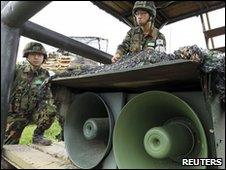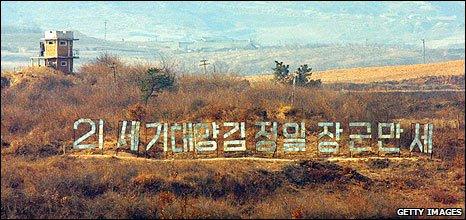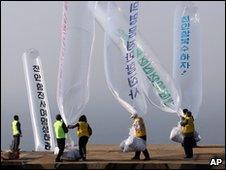Inter-Korean crisis: Propaganda fight
- Published
South Korea has resumed propaganda operations against North Korea, amid a crisis in relations. Seoul has blamed its communist neighbour for the sinking of a warship in March, but Pyongyang denies this.
BBC News looks at some of the methods both countries have used in the past to get their message across the border.
Loudspeakers

Both sides agreed in 2004 to stop using loudspeakers for propaganda
On 24 May, South Korea began reinstalling loudspeakers close to the border with the North, having removed them in 2004 when relations between the two countries appeared to be improving.
The speakers, at 14 points along the demilitarised zone (DMZ), will blast messages across the border about life in the South.
Until 2004, the North also broadcast messages over the border, encouraging South Koreans to defect. Pyongyang has threatened to open fire on the South's loudspeakers.
The South has also resumed radio broadcasts into the North - a four-hour programme called Voice of Freedom will be played three times a day.
The first programme carried a speech from South Korea President Lee Myung-bak, messages about freedom and democracy, a song about freedom of choice and comments about how obesity is more of a problem than famine in the vastly more affluent South, an army spokesman told the AFP news agency.
Display boards
Seoul has said it will also place 11 giant electronic panels along the DMZ, to display similar messages in lights.

A 2003 image shows the North Korean sign clearly visible from across the border
North Korea has used a similar technique in the past, with one sign on its side of the DMZ spelling out in huge letters the message: "Hurrah for the sun of the 21st Century, General Kim Jong-il".
Leaflet drops

Seoul has tried to dissuade the activists in the past
North Korea has claimed that Seoul fabricated the results of the investigation into the Cheonan sinking in order to provoke a confrontation. To counter this South Korea says it will drop thousands of leaflets across North Korea carrying the details of the investigation's findings.
Peace activists in South Korea, who have often in the past floated leaflets across the border attached to large helium balloons, have also resumed their efforts. Previous campaigns have carried messages about freedom and democracy but have also criticised leader Kim Jong-il.
Seoul has in the past tried to discourage the activists, over concerns that personal criticism of Mr Kim could actually encourage anti-South sentiment.
DMZ villages
In the 1950s, North Korea began construction of the modern town of Kijongdong, in the demilitarised zone. Its modern concrete apartment buildings, complete with electricity, were designed to showcase the best of North Korean collective living to anyone looking over the border. It also sports the largest flagpole in the world - at some 160m (525 ft).
But observers believe the village has never been fully inhabited and that the buildings are empty shells, with lights turned on and off to give the illusion of a busy community.
South Korea also has one small village in the DMZ - Taesungdong, which has its own large flagpole. Its population is heavily protected by the military.

Kijongdong features the largest flagpole in the world
North Korean media
North Korea's state routinely broadcasts fiery propaganda against the South to its domestic audience. It has dismissed the South's accusations over the Cheonan as "a whopping lie cooked up by the group of traitors".
"Its brigandish farce is a hideous crime to be recorded in the history of inter-Korean relations," said one report.
But despite the tensions, a domestic television news bulletin on 25 May did not feature the incident until near the end of its programme, after reports on rice planting, a blanket factory and road safety.